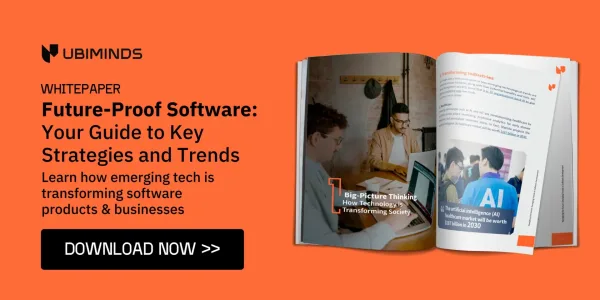Quantum computing is rapidly transitioning from theoretical research to practical applications. For software engineers, understanding quantum computing’s principles and leveraging its capabilities can unlock new opportunities for innovation.
But while quantum computing is a hot topic, there is still a gap in resources focusing on how software engineers can integrate or leverage quantum computing in their workflows and software development. This is Ubiminds’ shot at it.
The Rise of Quantum Computing
Quantum computing represents a fundamental shift in how computation is approached. It leverages the principles of quantum mechanics to solve problems that are intractable for classical computers. From optimizing complex systems to revolutionizing cryptography, its potential is immense.
Unlike classical computers, quantum computers exploit phenomena like superposition, entanglement, and quantum interference to perform operations on qubits—allowing for massive parallelism and exponential speedups in solving certain classes of problems.
As industries increasingly adopt quantum solutions, software engineers must bridge the gap between classical computing paradigms and quantum capabilities. Let’s explore how you can prepare for this!
Why Software Engineers Should Care About Quantum Computing
Emerging Use Cases Require Software Expertise
Quantum computing excels at solving problems that involve massive datasets or complex optimization. For example, it can optimize supply chain logistics, simulate molecular interactions for drug discovery (e.g., pharmaceuticals), and enhance machine learning models.
As a software engineer, learning quantum computing allows you to tackle these challenges more efficiently. Start by identifying problems in your domain that could benefit from quantum speedups, such as combinatorial optimization or cryptography.
Collaboration Across Disciplines
Quantum projects often involve interdisciplinary teams. Engineers must communicate effectively with physicists, mathematicians, and domain specialists to turn theoretical breakthroughs into practical applications. Cultivating this collaborative skill is crucial.
Career Opportunities
The demand for quantum computing expertise is growing. Companies like IBM, Google, and Microsoft are investing heavily in quantum research and development. By acquiring quantum skills now, you position yourself as a valuable asset in this emerging field. Explore job postings and research roles that require quantum knowledge to understand the skills employers are seeking.
Future-Proofing
Quantum computing is still in its early stages, but its impact will be profound. By familiarizing yourself with quantum principles and tools, you’ll be better equipped to adapt as the technology matures. Dedicate time to learning the basics of quantum mechanics and linear algebra, as these are foundational to understanding quantum computing.
Understanding Quantum Computing: Key Concepts and Technologies
Mastering the Fundamentals
Before jumping into quantum programming, understand the foundational principles:
- Superposition allows qubits to exist in multiple states simultaneously, which creates computational parallelism.
- Entanglement enables qubits to influence each other’s states, forming the basis for quantum correlations and faster computations.
A strong grasp of these concepts will guide how you approach building algorithms and optimizing quantum circuits. Resources like IBM’s Quantum Computing Primer are excellent starting points.
Exploring Key Quantum Technologies
The three dominant quantum hardware architectures today are:
- Superconducting qubits: Used by IBM and Google, they are fast but prone to decoherence.
- Ion traps: Used by IonQ, they offer stability but are slower in operation.
- Photonic qubits: Emerging technologies like Xanadu’s allow room-temperature operation.
Selecting a framework like Qiskit or Cirq will help you simulate and experiment with these technologies without requiring access to physical quantum hardware.
How to Integrate Quantum Computing into Software Development
Designing Hybrid Systems
Most practical quantum applications today rely on hybrid systems, where classical and quantum computers work together. For example, a classical computer might handle data preprocessing, while a quantum computer solves a specific optimization problem. To implement hybrid systems, explore frameworks like Qiskit Runtime, which allows seamless integration between classical and quantum workflows.
Current quantum computers lack the robustness to handle all computations; instead, they complement classical systems. For example:
- Quantum-classical hybrids process computationally expensive tasks (e.g., optimization problems) on quantum hardware while running logic and data preprocessing on classical systems.
- Use cloud platforms like IBM Quantum to design workflows where quantum computing handles specific subroutines.
Quantum APIs
Quantum APIs provide access to quantum hardware and simulators without requiring deep expertise in quantum mechanics. Platforms like IBM Quantum and AWS Braket offer APIs that let you run quantum algorithms on real hardware. Start by experimenting with these APIs to understand how to submit jobs, retrieve results, and interpret outputs.
Understanding Problem Decomposition
Learning to break down problems into quantum-solvable components is key. For example, a supply chain optimization problem may involve classical steps for data gathering but leverage quantum algorithms for the core optimization task. Mastering this decomposition ensures efficient use of quantum resources.
Simulators
Quantum simulators allow you to test algorithms on classical hardware before running them on quantum computers. This is especially useful for debugging and optimizing your code. Use simulators like Qiskit Aer or Cirq’s built-in simulators to test your quantum circuits and ensure they behave as expected.
Getting Started: Tools and Frameworks for Engineers
Choosing the Right Framework
Hands-On Learning
- Start with simple problems like building a quantum random number generator using a single qubit in superposition.
- Progress to building quantum circuits that solve linear algebra problems, as linear transformations are fundamental in quantum algorithms.
Optimizing Tool Usage
Use quantum simulators extensively before deploying on real hardware. Simulators allow you to debug circuits without worrying about noise or decoherence, which are common issues on physical systems.
Basic Quantum Algorithms Every Developer Should Know
1. Shor’s Algorithm for Factoring
Shor’s algorithm efficiently factors large numbers, which has significant implications for cryptography.
Shor’s Algorithm is a quantum approach to integer factorization, crucial for cryptography. To get started:
- Key Concepts: Modular arithmetic and quantum period finding are the building blocks of Shor’s Algorithm.
- How to Learn: Start with tutorials in Qiskit, where you can simulate Shor’s Algorithm in action. Focus on understanding how quantum Fourier transforms (QFTs) assist in period finding.
- Optimization Tips: Minimize circuit depth when simulating on noisy quantum hardware to mitigate decoherence.
While implementing Shor’s algorithm is complex, you can start by understanding its components, such as the quantum Fourier transform. Use simulators to test small-scale implementations and explore its potential impact on encryption.
2. Grover’s Algorithm for Searching
Grover’s Algorithm provides a quadratic speedup for unstructured search problems. It’s useful for tasks like database searching and optimization.
- Applications: Useful in optimization problems, cryptography, and search-related tasks.
- How It Works: Grover’s diffusion operator increases the probability of the correct result by amplifying specific states.
- Implementation Advice: Use Cirq or Qiskit to construct Grover’s circuits. Test the algorithm with small datasets before scaling to simulate real-world use cases.
To implement Grover’s algorithm, start with a simple search problem and use Qiskit or Cirq to build the circuit. Experiment with different oracle functions to see how the algorithm behaves.
3. Variational Quantum Eigensolver (VQE)
VQE is a hybrid quantum-classical algorithm used to find the ground state energy of a molecule, making it essential for quantum chemistry simulations. It combines quantum circuits with classical optimization techniques.
- How It Works: VQE combines quantum circuits to evaluate solutions and classical optimization to refine them iteratively.
- Applications: Used in industries like energy, where it helps simulate molecular structures or optimize catalysts.
- Implementation Tips: Use PennyLane for its hybrid quantum-classical capabilities. Integrate VQE workflows with TensorFlow for custom optimizations.
To implement VQE, use frameworks like Qiskit or PennyLane, which provide built-in tools for variational algorithms. Start by simulating simple molecules like H₂ to understand how VQE works and gradually move to more complex systems.
Quantum Fourier Transform
The Quantum Fourier Transform (QFT) is a key component of many quantum algorithms, including Shor’s. It transforms qubits from the time domain to the frequency domain.
- Key Features: The QFT transforms quantum states into their frequency domain, enabling efficient solutions for problems like period finding and phase estimation.
- Learning Path: Use Qiskit to implement QFT on small qubit systems. Start by building basic circuits and study how QFT simplifies solving equations in quantum systems.
- Optimization: Minimize the number of gates when implementing QFT, as excessive gate usage can introduce errors on current noisy hardware.
Practice implementing QFT using quantum gates and explore its role in algorithms like phase estimation.
Challenges in Implementing Quantum Computing for Software Engineers
1. Hardware Limitations
Quantum computers today are noisy and error-prone, with limited qubits. To mitigate these challenges, focus on error mitigation techniques and hybrid algorithms that work within current hardware constraints. Stay updated on advancements in quantum hardware to understand when new capabilities become available.
Engineers should:
- Learn error mitigation techniques like readout error correction.
- Use simulators to validate algorithms before deploying on noisy quantum hardware.
2. Complexity of Quantum Programming vs. Skill Gaps
Quantum computing requires knowledge of quantum mechanics, linear algebra, and advanced mathematics. To bridge the skill gap, take online courses like IBM’s Quantum Computing Fundamentals or edX’s Quantum Mechanics for Everyone. Practice coding quantum algorithms to reinforce your learning.
Quantum circuits require non-intuitive logic. Simplify workflows by using prebuilt libraries (e.g., Qiskit Aqua for quantum applications).
3. Integration Complexity
Quantum computing frameworks often lack compatibility with enterprise systems. To address this, use APIs and middleware tools to integrate quantum workflows into existing architectures.
Engineers should start with small, well-defined problems and gradually scale up. Use modular design principles to separate classical and quantum components, making it easier to debug and optimize your code.
Future of Quantum Computing in Software Engineering
As quantum hardware improves, its applications in software engineering will expand. Expect advancements in quantum machine learning, optimization, and cryptography. Stay informed by following research papers, attending conferences, and participating in quantum computing communities.
Opportunities in Quantum SaaS
Cloud platforms are democratizing quantum computing. Engineers must:
- Explore how to build quantum applications that leverage SaaS platforms like Azure Quantum.
- Focus on scalability, ensuring systems can handle increased quantum workload demand.
Focus on Sustainability and Accessibility
The future will see efforts to optimize quantum systems for energy efficiency. Engineers can:
- Build quantum applications that solve sustainability challenges, such as energy grid optimization.
- Advocate for open-source quantum frameworks to increase accessibility for developers worldwide.
Conclusion: Preparing for the Quantum Revolution in Software Development
Quantum computing is not just a scientific curiosity—it’s a technology that software engineers can and should engage with. By learning the fundamentals, experimenting with tools, and staying informed, you can position yourself at the forefront of this transformative field. Start your quantum journey today by exploring resources like IBM Quantum, AWS Braket, and PennyLane.
It offers software engineers unprecedented opportunities to revolutionize industries. By mastering its principles, experimenting with frameworks, and learning to integrate quantum capabilities into existing systems, engineers can lead the charge into this exciting frontier.
Start small, think big, and take incremental steps toward mastering quantum computing. Whether it’s exploring Shor’s algorithm, building hybrid systems, or leveraging tools like Qiskit and Cirq, your journey into quantum development begins today!

International Marketing Leader, specialized in tech. Proud to have built marketing and business generation structures for some of the fastest-growing SaaS companies on both sides of the Atlantic (UK, DACH, Iberia, LatAm, and NorthAm). Big fan of motherhood, world music, marketing, and backpacking. A little bit nerdy too!










